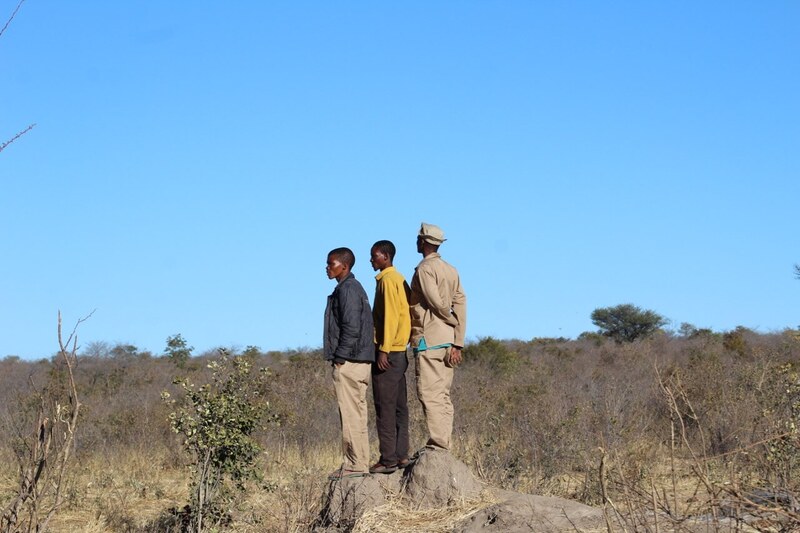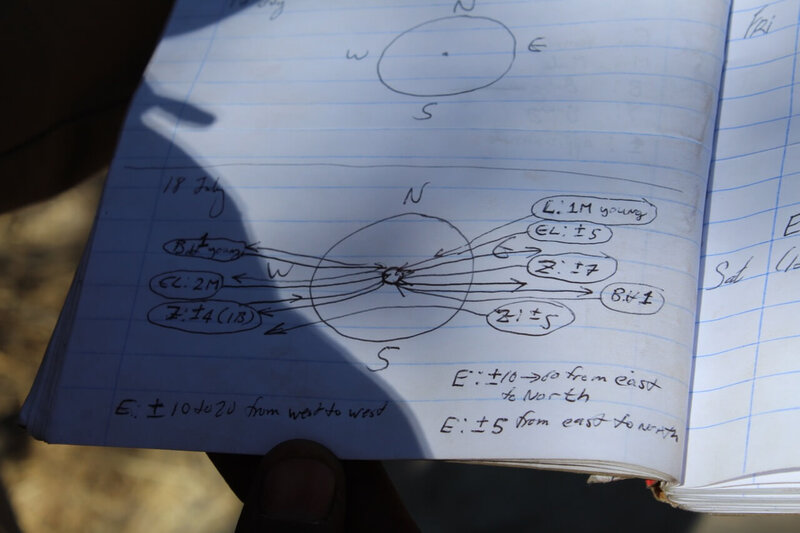|
Our last news update (see 8th April entry below) coincided with the start of a strict two month nationwide lockdown in response to Covid-19, and not being in direct contact with our field teams, we used the time constructively to complete the WWF-Namibia sponsored Khaudum-Ngamiland Wildlife Dispersal Area Heritage Trail: Feasibility Study (Final Report), in May 2020. We hope to make parts of this study accessible soon, but for now the map below highlights some of the study's main proposals. In a nutshell: a new 750km adventure 4X4 route linking up with a number of proposed new wildlife / wilderness and cultural tourism activity nodes (see red and green markers in map), will provide nature-orientated visitors with access into a largely unknown and unutilized wilderness area of around 4 million hectares in extent! This community based initiative has been planned in close consultation with local communities: their traditional knowledge systems are central to its planning and to the planned showcasing - in the envisaged tourism activities along the trail - of the traditional culture and ways of life of local San (Bugakhwe; Ju/hoansi), Herero and other ethnic groups. It will comprise a collective of tourism activity areas exclusively owned by these communities, but marketed and operated in partnership with the private sector, which will offer a level of wilderness and cultural immersion and authenticity that is increasingly hard to find, and as a result increasingly sought after by travellers. Above all, the Heritage Trail project will empower communities to diversify their livelihood base, and to own and sustainably manage their natural resource base. Faced with the current pandemic-era related challenges, we have formulated a holistic approach to tourism implementation that will target the more resilient local and international (self-drive and mobile safari) tourist markets, whilst also facilitating opportunities for human-wildlife conflict mitigation and the sustainable consumptive use of natural resources. Use of wildlife boreholes (more are planned to the ones we already operate), early winter rotational burning (to reduce hot unseasonal fires and promote vegetation recovery), reduced livestock stocking levels, and facilitation of community access to areas rich in edible, nutritious wild plant food resources, are just some of the integrated aspects relating to the identified focal areas. Careful cognizance has been taken of the need to avoid negative impact on the wilderness and cultural sensitivities and where feasible these attributes will be strengthened, as ultimately they are - in combination with one another - the critical "USPs" (unique selling points) that will enable sustainable tourism to succeed in this remote area. The project mission statement is to "address the inter-dependent conservation and poverty eradication challenges through the development of a viable and attractive tourism product, linking the Khaudum Ngamiland Wildlife Dispersal Area's natural and cultural attributes." Financial support is needed to implement the next phases in partnership with local communities, starting off with three of the identified 12 focal priority areas (nodes). For more information on how you can support this initiative, please contact us at [email protected]. Below are some selected photos from our field work activities in June and July, centered around the /Gui!han (western) and Morama (eastern) wildlife boreholes equipped by KWT last year (see previous blog updates). Currently about 20 community members from five community localities are employed on a part-time or full time basis to maintain and monitor these boreholes and surrounding wildlife habitats. This income is vital to them and their families, especially now that Covid has resulted in cancelled tourism bookings. You can help to mitigate the Covid economic impact by donating towards our community wildlife monitoring program, and in so doing - aside from generating livelihood income - you will be helping to ensure the continued rehabilitation of a globally significant migratory wildlife corridor linking Botswana's Okavango Delta to Namibia's conservation areas (Khaudum National Park and Nyae-nyae Conservancy). Our plan is to adequately fund and equip the community field teams and to expand the program even further so as to employ more people, from more communitites, and increase the total extent of wildlife habitat (including 100km of the international borderline) under monitoring surveillance and community protection. Please contact us for more details on how to assist ([email protected]): all donations go directly towards supporting activities on the ground, where it matters the most! We wish to also thank Morama Trustee Mr Peter Stevens for his recent fundraising effort and donations via Dambari Wildlife Trust (UK), which contributed towards the operating costs of the Eastern (Morama) wildlife borehole. We are also open to bookings for 2021 for the Hunter Gatherer Experience centred around Kagusi wilderness campsite: this is a unique, low-volume (low impact) cultural and wilderness immersion experience led by the most independent and subsistence-based Ju/hoansi San remaining in Botswana, which directly contributes to household incomes for families from four nearby localities and helps to generate funds for KWT's community livelihood and conservation programs. As with the community wildlife monitoring, this tourism enterprise is thus integral to encouraging preservation of wildlife habitat, the transfer of traditional skills to younger generations, and to preventing the influx of cattle owned by outsiders (not from these communities). By the boreholes operating in these remote localities, they serve a vital role in helping to alleviate human-wildlife conflicts, especially with regards to elephants, by attracting wildlife away from unsafe human populated areas. Last year, by opening up these new water points, we helped to reduce drought-related wildlife die-off when most of the Okavango Delta floodplains were bone dry: this action saved possibly hundreds of wild animals in the process, and enabled the surviving populations to bounce back strongly this year, in terms of their physical condition, behaviour and population recruitment (young being born and surviving). They also serve an increasingly vital function as relatively safe refuge for elephants, zebra, eland, gemsbok, roan, hyena, leopard and other free-ranging species in an ecosystem that - although still vast and wild - is becoming increasingly impacted, on its peripheries, by human population expansion, which is undermining migratory wildlife access to traditional dry season home range areas. In a sense we now need carefully considered artificial intervention, in order to conserve an increasingly human-impacted ecosystem. This is the reality affecting most of Earth's remaining wild places. Furthermore, by promoting non lethal methods of human-wildlife conflict mitigation, and sustainable community based tourism and non-commercial resource use (wild plant foods being a major unused food resource for example), we aim to create replicable models that can be supported by local communities and which can demonstrate that safari (trophy) hunting and costly lodge-type tourism developments (which are at any rate impractical in remote semi-arid areas), are unnecessary to the effective conservation this fragile, semi-arid wilderness. Other work engagements in remote community areas (also requiring further funding support), includes: oral history recording, territorial land mapping, Covid related education, prevention and support (sanitizing stations for visitors, distribution of masks, medicines and food support to reduce unnecessary contact with large settlement populations and the health risks when such contacts are made). Countering attempted land grabs of Ju/hoansi traditional lands is also an ongoing challenge requiring sustained focus, and support.  Border fence-line separating Botswana (right hand side) from Namibia: cross border wildlife movement is becoming increasingly regular thanks to elephants breaking through these unmaintained fences, in the process restoring the natural wildlife movment dynamics which existed prior to 1958 when the first border-line fence was constructed under a colonial era directive, effectively bisecting Ju/hoansi lands in two. Red-billed Queleas at the Eastern borehole. July 2020
1 Comment
Michael Bock
5/3/2021 04:45:43
Hello, where can I find your April 8, 2020 comments mentioned at the beginning?
Reply
Leave a Reply. |


















